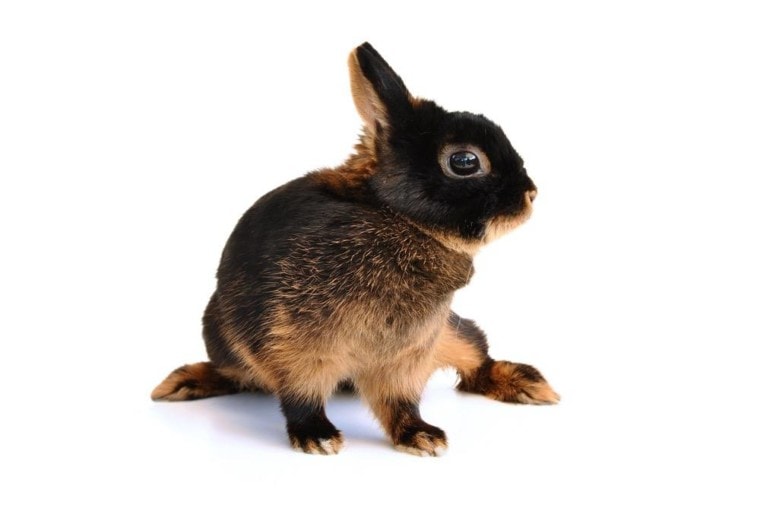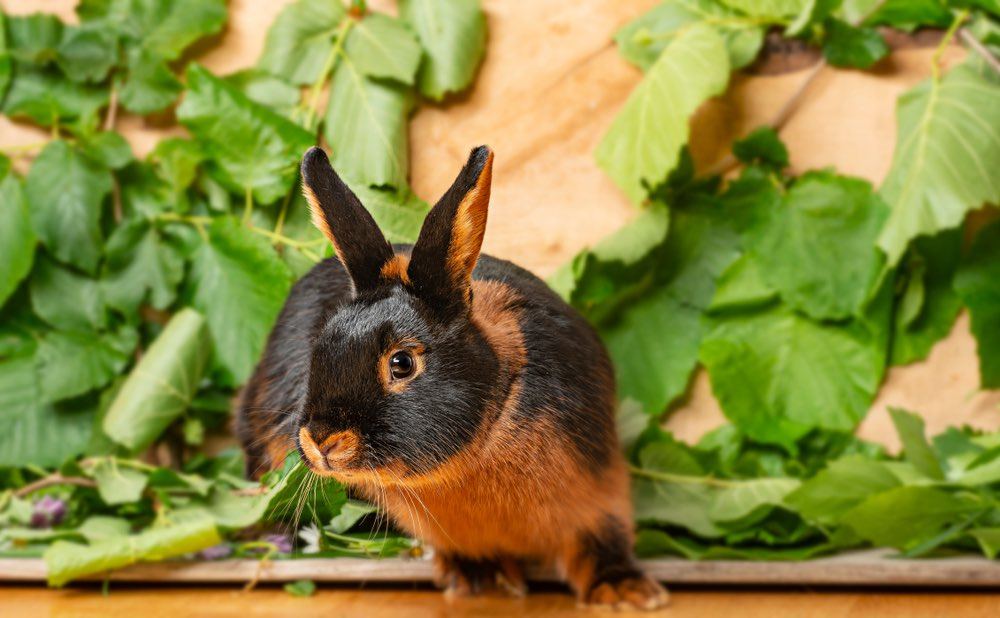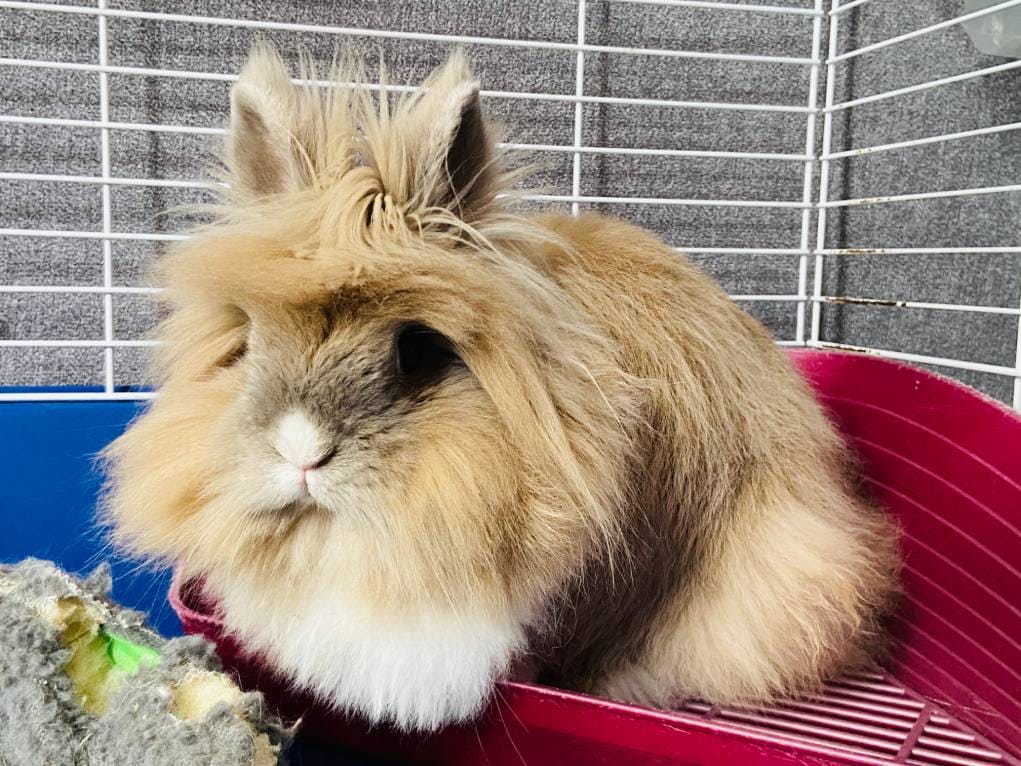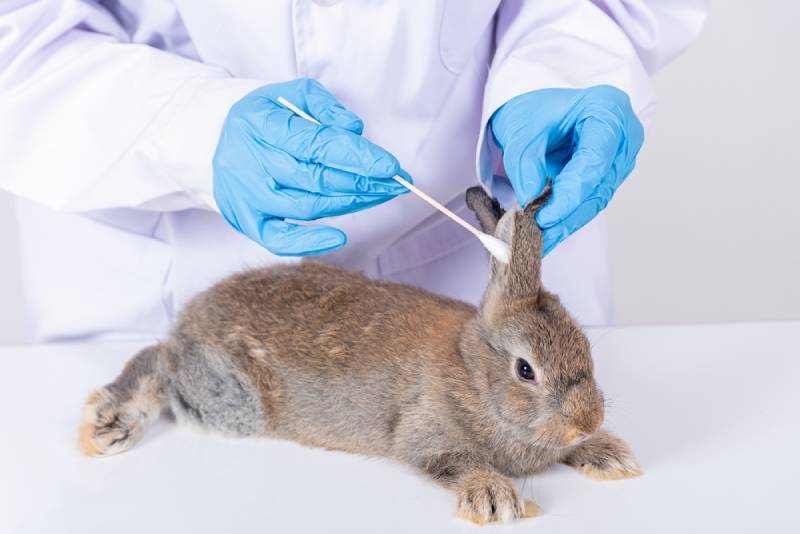
If you’re looking to adopt a bright, beautiful, and aristocratic rabbit to live on your property or within apartment walls, the Tan Rabbit will be a great choice. Curious by nature, it has a sweet personality and is quick to adapt to new environments. This is a fancy breed, by the way, meaning Tan Rabbits often participate in various shows/competitions. They can be a bit stubborn, but with early socialization and proper training techniques, you can turn a Tan into an amazing companion!
| Size: | Small/Average |
| Weight: | 4 – 6 pounds |
| Lifespan: | 8 – 10 years |
| Similar Breeds: | Harlequin Rabbit, Thrianta Rabbit, Dutch Rabbit |
| Suitable for: | Active families with adult children |
| Temperament: | Curious, playful, active, sweet-tempered, friendly |
Tan Rabbits are not only cute and friendly but also intelligent, inquisitive, and highly energetic. That means they’re hard to keep up with, especially for a first-time owner. However, if you have experience with rabbits and are ready to take on “extra work”, they’ll quickly turn into your favorite pets. How much do these buns cost, though? Are Tan Rabbits good with little children and other domestic animals? And finally, how do you feed, train, and exercise a Tan Rabbit? Read on to find out!
Tan Rabbit Breed Characteristics
How Much Do These Rabbits Cost?

As a fancy breed, the Tan Rabbit is a go-to choice for shows and exhibitions, yet it is also a great pet. The origins of the Tan date back to late 19th century England. It is a result of crossbreeding between wild European rabbits and domestic Dutch buns. The very first Tan Rabbits were black, but local breeders were quick to develop new varieties and colors. In 1891, these rabbits got their first club in England; the ATRSC (American Tan Rabbit Specialty Club) was founded in the 1960s.
Tan Rabbis are classified as a “running breed”: they get to move freely on the judging table instead of being stuck in a cage. These lovely buns are valued for their bright, sleek coats, intelligence, and engaging personality. On average, a rabbit like that will cost $50–$100 if you buy it from a reputable breeder. But it’s very well possible to find one for $30–$40. A local animal shelter might be willing to give it away for even less ($10–$15). Don’t go for the lowest price in the area, though.
If the rabbit is suspiciously cheap, it might have a bad health history. This is especially true if you’re going for a show rabbit, as those chaps usually cost significantly more: up to $400. So, how do you know for sure that the breeder can be trusted? The best source for finding a good deal is ARBA (American Rabbit Breeders Association); it has an extensive list of sellers that specialize in various rabbit breeds.
Temperament & Intelligence of the Tan Rabbit
Tan Rabbits don’t really love to cuddle—that’s the first thing to keep in mind. True, they are spunky little troublemakers and don’t mind spending time with their owners. However, Tans aren’t the most affectionate rabbit breed on the planet. In fact, while they do create a bond with their human moms and dads, they don’t like to be touched, stroked, or held for too long. If you’re lucky, your Tan will be all cuddly, but generally, they prefer to keep to themselves.
Do These Rabbits Make Good Pets? 👪
Yes, for the most part, Tan Rabbits are wonderful pets. They can live both indoors and outdoors and are praised for their witty, energetic, and friendly attitude. This is only true for people that can catch up to them, though. For example, most seniors and young kids will have a hard time trying to match their energy. So, you should only consider adopting a Tan Rabbit if you have grown children that know how to treat these rabbits and are ready to spend extra time with them.
In that scenario, Tans will be well worth the investment.
Does This Rabbit Get Along With Other Pets?
Thanks to their curious nature, Tans don’t take long to make friends with fellow rabbits. That said, if you have a hamster in the house, it’s NOT recommended to bring a Tan in. Like the vast majority of bunnies, they don’t get along well with hamsters. Rabbits are bigger, stronger, and more aggressive. More than that, these animals interpret each other’s signals differently, and that often leads to conflicts.
But what about cats and dogs, though—can they co-exist with Tan Rabbits? This greatly depends on socialization. If the buns and cats/dogs have been growing under the same roof, there’s a very good chance they’ll be good friends. Unfortunately, if you’re introducing the bun to an adult canine or feline and the bigger pet has a high prey drive, the rabbit will always be stressed.
Things to Know When Owning a Tan Rabbit:
Food & Diet Requirements 🥕
Rabbits mostly eat hay, and Tans are no exception to that rule. See that it makes up 70% of their diet. Go for high-quality hay and mix it up now and then with grass hay treats. To fill up the remaining 30%, stock up on fruits, veggies, herbs, and, of course, pellets, as they are rich in minerals, vitamins, and other important elements. The diet should include a healthy amount of fiber, too. Rabbits can’t vomit, so any coat hair that they accidentally swallow will get stuck in their GI tract.
Thankfully, with the help of fibers, the pet should be able to get it out of its system. Also, speaking of food, on average, you’ll only have to pay $15–$25 to keep a Tan bun well-fed and the litter nice and fresh. That’s a fair price for owning a rabbit, but you should also consider vet visits, vaccinations, meds, various care products, toys, and more. Talk to a veterinarian about the best diet for your Tan Rabbit based on its health history, age, sex, activity level, and temperament.
Habitat & Hutch Requirements 🏠
Earlier, we mentioned that Tan Rabbits are quick to adapt to new environments and can live happily both indoors and outdoors. That’s very much true, but you will have to invest in a cage (if the bun is going to live in the house or apartment) or a hutch (if you decide to move its abode outside). On average, cages cost $50–$100, while decent-quality hatches are available for $100–$200. A 12-square-foot cage is a good place to start for most Tans. A smaller cage will limit its movements.
The cage should be 50% wider and 150% longer than the pet. No matter where you put the rabbit, it needs to have the ability to exit its “home” and run around the room or the yard to stretch its legs and exercise. Next, make sure the furry bud has enough bedding and toys (along with bowls and bottles) to rest comfortably and stay active. A quick note: Tan Rabbits hail from the UK and handle cold weather with winds and rain better than heat.
Exercise & Sleeping Needs 🐇
Some Tan Rabbits like to play in cardboard boxes; others pick rope toys and stick with them. And then some buns prefer to spend time with their owners. Your goal as the bunny parent should be to introduce the pet to as many toys and exercises as possible so that it can choose the ones that it likes. Moving on to a different subject, Tans aren’t at all needy when it comes to sleeping. As long as the bedding is nice and soft and the cage or hutch is large enough, these chaps will sleep like babies!
Sunset and daybreak: that’s when Tan Rabbits are mostly active. So, it would be best to let them lose when it’s dark outside to run around, investigate, and be their selves. Just make sure there aren’t any cables or wires in their way, as it will take less than a minute for these buns to chew through them. And if you have other pets on the property, they should not have access to the area where the bunny lives.
Training
One of the best things about Tan Rabbits is they don’t need nearly as much training as other buns to participate in a show. Naturally, they like to be at the center of attention and show off, and that’s what makes them great competitors. On the downside, Tans are hyperactive pets and rely on positive reinforcement to stay happy. Also, if you recently bought the bun a crate or hutch, you will have to give the pet time to recognize it as its new home.
Lock the hutch regularly so that the rabbit knows it’s supposed to stay in there. Potty training comes next, and it takes quite a bit of effort. What you have to do is move the bun and its droppings into the cage/hutch every time it uses the bathroom outside. Put the dung in the litter box for the odor to spread. Repeat the process for a short while and the Tan will start doing its business in the box. Clean the hutch once in 1–2 weeks and keep the hay nice and fresh.
Grooming ✂️
Tan Rabbits have a coat to die for, but that doesn’t mean you’ll have to spend long hours taking care of it. On the contrary: Tans require almost no grooming at all—they take proper care of themselves. So, does that mean you shouldn’t wash this rabbit? No, full baths are NOT recommended, as they put rabbits through a lot of stress. In the worst-case scenario, you may even kill the poor thing trying to bath it!
Use the spot-cleaning technique instead. This way, you’ll be able to keep the bunny clean without putting it at any risk. Brushing is still important, though, as it does a great job of removing dead hair. If you skip a session or two, all that fur will end up on the carpet, the furniture, or inside the little guy’s stomach. Do it once a week during the “normal” days and twice a week during the shedding season (also, switch to a slicker brush).
Lifespan and Health Conditions 🏥
Tans are full-arched rabbits and have a showy arch that runs from the hips to the neck and back. That’s why they’re relatively small compared to other breeds yet lean, agile, and flexible. Generally, Tan Rabbits are healthy animals, and the average life expectancy is roughly the same for bucks and does: 8–10 years. That said, they are still prone to a relatively short range of medical issues. Here’s a quick look:
Male vs Female
In contrast to most mammals that inhabit the planet, rabbit males are a bit smaller and lighter compared to the females. The same is true for Tan Rabbits. The does weigh around six pounds (2.7 kilograms); the bucks fall a bit short with 4.5–5 pounds (2.5 kilograms). While the average bunny owner might not be able to notice this, an experienced breeder will be able to tell if it’s a male or female bun by looking at its size.
They aren’t that different in temperament, however, and have roughly the same behavioral patterns. But, although both sexes live longer when sterilized, females benefit more from being spayed. The thing is that does are highly susceptible to cancer (ovarian/uterine). Thankfully, rendering the bunny sterile greatly reduces the risk of endometrial adenocarcinoma. The males, in turn, will have a better chance of avoiding prostate cancer when neutered.
3 Little-Known Facts About Tan Rabbits
1. Tan Rabbits Come in Four Different Colors
ARBA only recognizes four Tan Rabbit varieties. We’re talking about the black, blue, chocolate, and lilac bunnies. Originally, Tans were black. However, soon after they were discovered, professional breeders in the UK developed blue buns (in 1900, to be exact). In 1908, the ARBA accepted Tans as a standalone breed. The chocolate rabbits came around in the 1920s. According to various sources, it was the result of breeding a Tan with a chocolate Havana.
The lilac variety was added in 1927. Now, the “OG” Tan Rabbits were quite different from the buns that we have today. If you go to a breeder and ask for a Tan, you’ll get a nimble, shiny pet with long limbs, whereas the true Tan Rabbits were a bit shorter yet heavily built. So, why did these changes occur? Partially, they were caused by the introduction of Belgian Hares into the mix. We also have the shows and competitions to blame for that.
2. They Get Aggressive During the Mating Season
Tan Rabbits might not be the cuddliest pets on the planet, but they do have a soft side, especially for people they love and trust. And most of the time, they are sweet and calm tempered. However, they do get aggressive when the mating season kicks in. Therefore, if you feel like your bun is acting a bit strange or showing signs of unprovoked aggression, most likely, that’s caused by the hormones that activate during the breeding season.
This usually starts in March and ends in late summer or early autumn. Also, when does have kittens, they tend to get overprotective, and that can make them hostile as well. A quick note: a doe is a female rabbit, while a kit/kitten is a baby bunny. So, just know that this is normal behavior, and don’t react in any way. Still a bit worried? Well, to be 100% sure that the rabbit is ok, have it checked by an animal doctor.
3. Each Year, the ATRSC Hosts a Tan Rabbit Show
The national show starts in March and welcomes breeders from every single state to participate in the competition. The winner receives a reward and nationwide recognition. And that’s not the only show hosted by this organization. In the fall, ATRSC holds a national convention with lots of educational contests. The American Tan Rabbit Specialty Club encourages both young and old breeders to participate and win scholarships.
Final Thoughts
These days, Tans are the go-to pets in the US and around the globe. They’re cherished for their easy-going, friendly character, beautiful coats, and compact size. If you live in a small apartment and want to adopt a bun, the Tan is a sure pick. Or, if you’re in the market for a show animal, this rabbit will also be well worth the investment. Speaking of the cost, regular Tans are quite affordable and don’t cost a fortune to feed and maintain.
That said, a well-bred bunny with a “royal” heritage will be a lot more expensive. Also, these rabbits pack more energy than most domestic animals. That makes them a less-than-ideal choice for the elderly or busy families with little children. At the same time, these witty, adorable buns can be amazing pets. They are loyal and loving and get a blast from spending time with you. Summing up, if you’re ready to commit, a Tan Rabbit will give you the time of your life!
Featured Image Credit: Arno van Dulmen, Shutterstock









